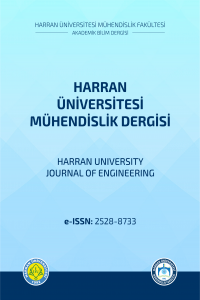GAP Bölgesinde Karbon-Nötr Ekonomiye Geçişte Yeşil Enerji Teknolojilerine Yönelik Değer Zincirinin Kurulması
Enerji üretimi ve tüketiminden kaynaklı sera gazı salımları, insan kaynaklı iklim değişikliğinin temel nedeni olarak kabul edilmekte, iklim değişikliğinin yaşam kalitesi, çevre, su, tarım ve gıda kaynakları ve ulusal ekonomiler üzerindeki olumsuz etkileri çerçevesinde, enerji sektöründe küresel ölçekte yeni arayışlar gündeme gelmektedir. Bu kapsamda Düşük Karbonlu Üretim teknolojileri birçok ülkede önemli fırsatlar oluşturularak, yeni istihdamların ve ticaret alanlarının gelişmesine katkı sağlamıştır. Benzer fırsatların GAP Bölgesi’nin kalkınmasında da etkili olabileceği yönünde çok sayıda gösterge mevcuttur. Bu doğrultuda mevcut çalışmanın temel amacı; GAP Bölgesi için düşük karbon ayak izini esas alan bir kalkınma modelinin ekonomik sistemi oluşturan tüm alt sektörlerde yapılacak uygulamalar ile hayata geçirilmesine ve Bölge’nin rekabet edebilirliğinin arttırılmasına katkıda bulunacak bir değer zincirinin belirlenmesidir. Bu amaçla Bölgede uygulanması gereken strateji ve eylem planlarının belirlenmesinde kullanılacak yenilikçi yaklaşımlar geliştirilmiştir. Bu yenilikçi yaklaşımların temelinde; Bölgede kullanım koşulları ve potansiyeli yüksek yenilenebilir enerji teknolojileri ile uygulaması henüz yaygınlaşmamış enerji verimliliği teknolojileri için bir değer zinciri oluşturulması yatmaktadır. Bu sayede, GAP Bölgesi’nin tüm üretim ve hizmet alanlarında kaynakların en etkin biçimde kullanımının modellenmesi, yaygınlaştırılması, verimliliğin arttırılması, karbon salımının azaltılması, sürdürülebilir ve yeşil büyümenin sağlanması mümkün olabilecektir.Bu çalışmada geliştirilen yenilikçi ve entegre yaklaşım sayesinde oluşturulacak tedarik, paydaş ve değer zinciri dikkate alınarak sürdürülebilir ve yeşil bir kalkınma modelinin nasıl oluşturulacağı detaylı olarak tartışılmakta ve bu amaçla yeni uygulama/iş modelleri önerilmektedir.
Establishment of Green Energy Technology Value Chain for Transition to Carbon-Neutral Economy in the GAP Region
The greenhouse gas emissions resulting from energy production and consumption are considered to be the root cause of the human-driven climate change and new global quests are at the top of the agenda of the energy sector within the scope of the negative effects of the climate change on the life quality, environment, water resources, agricultural and food resources and the national economies.Hence, the Low-Carbon Production technologies create opportunities and contribute to the new employments and the development of new commercial areas. There is a considerable amount of indicators pointing out that similar opportunities could well be influential in development of the GAP Region.The purpose of this study is to identify a value chain that will contribute to the realization of a development model that is based on a low-carbon footprint in all subsectors of the economic system and to improvement of the competitiveness of the GAP Region. For this reason, innovative approaches are developed to be utilized in the determination of the strategy and the action plans that are required to be applied in the region. What lies behind these innovative approaches is the generation of a value chain for renewable energy technologies with a high potential of application and favorable conditions and for energy efficiency technologies that are not yet widespread. Thus, it will be possible to model the most effective use of the resources in all production and service areas in the GAP Region, to improve the efficiency, to reduce the carbon emissions, and to ensure a sustainable and green growth.It is discussed here how the sustainable and green growth model will be created by the innovative and integrated approach developed in this study, taking into account the supply, stakeholder and value chains, and supported by application models.
___
- [1] Ekonomi Politikalari Perspektifinden İklim Değişikliğiyle Mücadele, TÜSİAD-T/2016 T/2016,12 – 583, Aralık 2016.[2] Monitoring the Transition to a Low-Carbon Economy, OECD Working Paper, 2015.[3] GAP YEEV Eylem Planı, GAP BKİ, 2011[4] Schlömer S., T. Bruckner, L. Fulton, E. Hertwich, A. McKinnon, D. Perczyk, J. Roy, R. Schaeffer, R. Sims, P. Smith, and R. Wiser, Annex III: Technology-specific cost and performance parameters, Climate Change, 2014.[5] Türkiye İstatistik Kurumu Verileri, Nisan 2016.[6] Kent-Bölge: Yerel Kalkınmada Yeni Dinamikler Türkiye’nin Kentlerinden Kentlerin Türkiyesi’ne, TÜRKONFED, 2017.[7] Angelakoglou K, Gaidajis G, Lymperopoulos K, Botsaris PN, Carbon Footprint Analysis of Municipalities – Evidence from Greece, Journal of Engineering Science and Technology Review, v8 n4 p15-23, 2015.[8] Laine J, Ottelin J, Heinonen J, Junnila S, Consequential Implications of Municipal Energy System on City Carbon Footprints, Sustainability J., doi:10.3390/su9101801, v9, 2017.[9] Bayazıt S, Önsal A, Türkiye İçin 2030 Kalkınma Gündemi; Binyıl Kalkınma Hedefleri Değerlendirmesiyle Sürdürülebilir Kalkınma Gündemi İçin Yol Haritası Önerisi, Kalkınma Araştırmaları Merkezi, 2017.
